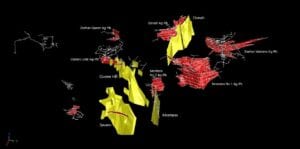Stellar Resources will restart drilling this year at its Heemskirk project, the company has announced.
The Heemskirk project, located in Tasmania, Australia, is comprised of several tin-containing deposits. The project already has a total Inferred and Indicated Resource of 6.6Mt at 1.1% Sn – some 71,000 tonnes of tin. However, Stellar is looking to expand this resource with further drilling.
The Heemskirk area has not always been prospective for tin. Historic mining focused on silver, with 17 such mines across Stellar’s two exploration licenses.
With no interest in tin, many “pyrite” veins were discarded as worthless by early miners, with no silver-lead mineralisation visible. Assay work was not conducted at the time; had it been, fine-grained cassiterite (tin) crystals may have been discovered.
However, Gippsland Minerals completed this work in the 1970s. The company discovered that these supposedly-barren veins contained tin. Using this information, Gippsland unearthed the Montana and Severn tin deposits in 1971. Similar mineralisation has been recorded at Oonah. The deposit already has an Inferred Resource of 0.59Mt at 0.9% Sn.
With this geological knowledge in hand, Stellar is targeting five historic silver-lead mines with its 2021 drilling campaign.
The Oonah target has previously been drilled to depths of around 200m. Stellar plans to drill two 400m holes to find whether the tin mineralisation extends further. Oonah was never mined for silver, and so the company is also hoping that the precious mineral will be present in its drill core.
Stellar will also put two drill holes into each of the Montana No. 1 Mine and the Zeehan Western Mine. Both historically produced silver, but the were only mined to around 200m. This is above where Stellar believes the silver mineralisation transitions to tin. The 2021 drill campaign will extend to at least 400m, hopefully into tin-bearing veins – although the lead-zinc-silver mineralisation may extend deeper.
The Zeehan Queen mine also produced silver in the past. However, mining stopped when the mineralised vein transitioned to pyrite; the vein was never assayed for tin. The extent of the deposit below the historic workings has never been found.
On top of the work at the silver mines, a drilling program targeting the Severn tin resource is also being drawn up. The resource has been drilled to around 500m, but it is hoped that mineralisation could continue to the underlying granite contact at around 1,000m below surface. The mineralisation is also thought to possibly increase in grade with depth.
Our view: With a good geological understanding of the area, it is quite possible that Stellar will intersect more mineralisation. Whether it will be further lead-silver or tin remains to be seen. As the mines were not drilled below the historic workings, it is possible that the silver mineralisation continues. However, Stellar has previously found tin below veins of the precious metal at Oonah, Montana, Queen Hill, and Severn.



